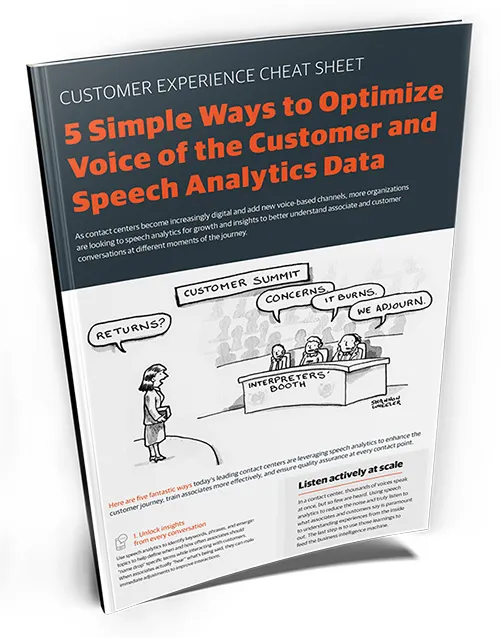Two forces are converging and fundamentally changing business: increasing data complexity and escalating customer expectations. Handling the former is a way to keep pace with the latter.
This situation underscores the urgency of integrating companies' data sources to gain a holistic view of the customer. Such efforts can shape an effective customer experience management (CEM or CXM) strategy that is hyper-focused on designing brand experiences to meet or exceed customer expectations. This will help to better engage customers when and where it matters most, and market to them in more targeted and tailored ways, while also improving customer satisfaction, loyalty, and advocacy.
Having this holistic, deep understanding of a prospect or customer is the foundation for successful customer experience management, but requires a universal profile—a snapshot of a customer's historical, transactional, and behavioral movements across the enterprise. To effectively gather this intelligence, organizations must integrate and analyze the data they cull from all channels. Very few companies, however, are able to look at their data across channels because of specific organizational challenges.
The danger of data silos
Complexities surrounding multichannel analysis often stem from the age-old problem of data silos. Many organizations' existing information systems were developed and deployed using ad-hoc approaches, resulting in information silos that make data sharing and integration among business units difficult. The bigger the company, the more harmful a role silos play, because having a holistic view of the marketing campaigns means having the ability to share customer preferences, feedback, and promotion history across channels.
I suggest three steps to bridge silos:
1. Shake up your organization. In many cases data silos are also the result of organizational silos—departments and managers operating separately from each other. Sometimes organizational silos are more difficult to break down than data silos.
Organizations that have successfully integrated their data flow and analysis across departments also have leaders who do what they're supposed to do: collaborate and embrace change. It doesn't work unless leadership leads and management helps everyone understand why change must happen and why they need to work together in new and different ways toward a common goal.
2. Be channel agnostic. For many marketers, this is a critical requirement. Campaign management tools create the visibility that marketers crave. Shared planning also makes it easier for marketers to promote knowledge and sharing of best practices. If there are campaigns that work particularly well in the inbound channel, then marketers should be able to easily replicate the logic, segmentation, and selection in outbound channels.
3. Create a cross-enterprise management team. Successful cross-channel analysis often requires an integrated management team, whose members share roles, business intelligence, and customer feedback. This team would also support relationship management teams by providing centralized data and producing regular reports on how specific data from cross-channel analysis affects their specific departments.
Avoiding the data quagmire
Avoiding the data quagmire Colin Powell once said, "Experts often possess more data than judgment." That statement applies to many data professionals and analysts today who face an ever-increasing amount of data. They are overwhelmed with data, tools, and statistics. As a result, they tend to overanalyze and overthink, which can create a data quagmire.
I often encounter marketers afflicted with this condition. Data analysis and reporting is a means to an end, not the end itself. If you find yourself mired in page after page of monthly reports, then you've lost sight of your goal. My suggestion is to start small. Here are five steps to help end your paralysis:
1. Choose one metric, but look at it holistically. With the deluge of data these days, marketers can get confused about which data points and measurement to focus on. I suggest first choosing a metric that gauges a business outcome that most impacts your organization on a daily basis, whether that includes customer satisfaction, cross-channel performance, customer retention, or even open rates. Focus on and analyze the associated data to help move the needle on that dashboard.
2. Deconstruct to construct. Examine customers' buying behaviors, understand their channel preferences and how they want to purchase, and market toward those buying indicators. These steps will go far in customer retention efforts.
3. Build a shared understanding. Information about the alternatives and criteria in a decision are understood from each team member's own perspective. But employees may not have a complete picture of the situation or the knowledge to develop a long-term view. The key here is to set up working environments that support the sharing of information necessary to help move the decision forward.
4. Rely on industry best practices. Use proven methods and tools that help your organization reduce risk and avoid data quagmires. Most important, these methods will keep your employees ahead of the curve.
5. Learn from your mistakes. Examine the outcomes of previous decisions. Evaluating your success requires keeping track of past choices, actions, and results.
Technology challenges of customer experience management
Once you've addressed the aforementioned steps of your customer experience management strategy, a critical phase in cross-channel customer analysis is consolidating your customer data onto a single platform and integrating your related marketing activities. Here are three steps to solving the technology integration challenge:
1. Go end to end. End-to-end data engines link all disparate data sources, including outbound calling and electronic and printed direct marketing, in real time. This helps to ensure that the entire integration cycle is automated.
2. Get touchy. Customer touch plans designed for each target customer segment and for each phase of the customer lifecycle will help to extend market coverage. In addition, apply data scenarios to continually analyze the effectiveness of a company's campaign components.
3. Digitize your processes. Digital direct marketing (DDM) campaigns help to consolidate and automate e-marketing efforts. This single step helps to generate emails that a company's customers would perceive as being relevant and personalized.
Immersed in analysis
It's no secret that organizations are experiencing a proliferation of data stemming from continuously emerging digital channels. The resulting explosion will further complicate and strain organizations' cross-channel analytical efforts. Companies that don't address the situation could negatively affect customers' experiences.
Real-time marketing communication, rich personalization, and a consistent brand experience are all crucial components to competing in the new economy and meeting ever-increasing customer expectations. These critical components will only be achieved through organizations' growing ability to obtain rich customer and business information across all channels, and to act on that in real time and with a consistent and relevant view to the customer.
As such, cross-channel integration and analysis is a key aspect of customer experience strategy best practices. Intelligence that is derived from integrating and analyzing the right information from the growing number of customer interaction channels will help you better understand how customers experience your brand. As a result, you will gain the necessary insight to make smarter business decisions, customize communications and marketing campaigns, and obtain the knowledge to drive effective process improvements.
More customer experience management resources to improve the customer experience
Here are some additional resources to help with your customer experience management and strategy.
Customer Journey Maps as a Customer Experience Tool: In this strategy guide, we explore key steps to help you understand the current state of your customer service and create an ideal future state. Learn what drives customer loyalty for your products and services, better understand the current customer journey, and generate new ideas to improve customer experiences so you can create
Digital Customer Experience Strategy - Six Key Areas to Focus your Efforts: By incorporating digital experience into a holistic customer journey strategy, companies can accelerate their digital transformation and move closer to frictionless customer experiences.
Loyalty Program Strategy - 5 Best Practices to align with your Business Strategy: We have identified five customer loyalty program best practices. In this article we go into additional details about each loyalty program strategy, as well as provide some examples of the outcomes these strategies can create to help increase brand loyalty and customer lifetime value.

5 Ways to Optimize Voice of the Customer and Speech Analytics Data: In this guide, learn 5 ways to use speech analytics and call center analytics software to augment employee experience on the floor and customer service over the phone. Today’s leading contact centers leverage speech analytics technology to enhance customer experience, train associates more effectively, and ensure quality assurance (QA) across all channels and at every contact point.
Unlock Customer Insights Hidden in Plain Sight: Customers have multiple contact options today beyond just voice calls. IVR, online self-service, virtual assistants, live chat, online forums, mobile apps, social media, and more. Chances are, you’re not optimizing the existing customer insights living in your contact center and beyond, across all of these touch points. In this strategy guide, we explain how businesses can combine existing data from multiple sources and start applying customer insights to deliver personalized experiences.
Channel Orchestration: Make Your CX Efforts Sing: Online and offline, there are now so many ways for a customer to interact with a brand, and seamless channel orchestration is critical to ensure great customer experiences. Moreover, a full view of the customer journey within your customer relationship management systems is also important. In this strategy guide, learn 4 keys to successfully orchestrating customer data and the user experience across multiple channels in order to make your CX sing.

















